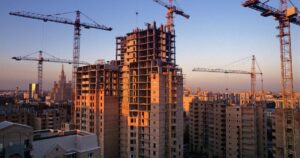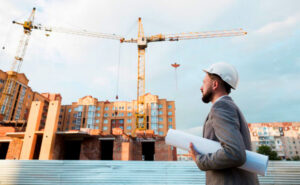
The total area of residential buildings for which construction permits (new construction) were issued in January-September 2025 increased by 48.4% compared to the same period in 2024, reaching 4 million 396.7 thousand square meters, according to the State Statistics Service (Gosstat).
According to the statistics agency, in January-September 2025, the total area of new construction of apartment buildings increased by 51.1% compared to last year, to 4.23 million square meters. The number of apartments in apartment buildings declared at the start of construction increased by 54.1% to 47,600.
Most of the new housing in the first nine months was registered in the Kyiv region: the total area of new housing construction amounted to 2 million 305.1 thousand square meters (21.2 thousand apartments), which is 142% more than in the first half of last year.
Significant volumes of new housing in the specified period were also registered in the Lviv region – 816,500 square meters (10,900 apartments), which is 63.6% more than in January-September 2024, as well as in Ivano-Frankivsk – 344,200 square meters (+8.2%, 5,500 apartments), Zakarpattia region – 368.7 thousand square meters (+26.1%, 4.7 thousand apartments), Poltava region – 160.3 thousand square meters (2.1 thousand apartments), Vinnytsia region – 167,100 square meters (-29.2%, 3,900 apartments) and Volyn region – 176,300 square meters (+25.3%, 4,000 apartments).
In Kyiv, in January-September 2025, the total area of new construction of housing amounted to 449,600 square meters (5,200 apartments), which is 36% more than last year.
The State Statistics Service reminds that the figures do not include territories temporarily occupied by the Russian Federation and parts of territories where hostilities are ongoing (or have been ongoing).
As reported, the total area of new housing construction in Ukraine in 2024 decreased by 7.2% compared to 2023, to 3.9 million square meters, while in 2023 it was 4.2 million square meters, in 2022 – 6.67 million square meters, and 12.7 million square meters in 2021.

According to the Serbian Economist, the investment company of Jared Kushner, son-in-law of US President Donald Trump, Affinity Partners, has withdrawn from the project to build a hotel and business complex on the site of the former building of the General Staff of the Yugoslav Army in the center of Belgrade.
According to Radio Liberty (Balkan service), the company has withdrawn its application for the project, which envisioned the construction of a luxury complex on the site of the General Staff buildings destroyed during NATO bombing raids in 1999.
According to a spokesman for Affinity Partners, the decision was made “out of respect for the citizens of Serbia and Belgrade,” as large projects “should unite, not divide” society.
The announcement of the company’s withdrawal from the project came against the background of the fact that on the same day, the Serbian Prosecutor’s Office for Combating Organized Crime filed an indictment against Culture Minister Nikola Selakovic and a number of officials. They are accused of abuse of power and falsification of documentation when the General Staff complex was stripped of its status of protected cultural heritage, which opened the way for commercial development of the site.
Kushner’s project during the year caused mass protests of the opposition, student and urban protection initiatives, which insisted on the preservation and restoration of the complex as an important monument of modernist architecture and a memorial site associated with the victims of the 1999 bombings. Activists called the investor’s rejection an “important victory,” but warned that the General Staff remains at risk of status changes and possible demolition in favor of other development projects.
The Serbian government and presidential administration had not commented on the information about Affinity Partners’ withdrawal from the project at the time of publication of the Radio Liberty piece.
Affinity Partners is a private investment company of Jared Kushner, created after his departure from Donald Trump’s administration and working with the capital of Middle Eastern and other institutional investors. In Serbia, the redevelopment project of the General Staff complex was realized through affiliated structures (including Atlantic Incubation Partners / Affinity Global Development) and envisioned an investment of about $500 million, a 99-year lease on the site and a profit share for the state of Serbia of about 22%, the New York Times and other media reported earlier.
https://t.me/relocationrs/1947

Construction, with a rate of 31.5%, made the largest contribution to Ukraine’s GDP growth in the third quarter of 2025, which, according to preliminary data, amounted to 2.1%, the State Statistics Service reported on Thursday.
According to its estimates of GDP using the production method, growth in public administration was 15.1%, in the supply of electricity, gas, steam, and air conditioning – 6.7%, in wholesale and retail trade and repair of motor vehicles – 2.6%, and in education – 2.2%.
In calculating GDP using the final use (or expenditure) method, which shows where resources in the economy were directed—to consumption, investment, or public services, the main growth in GDP in the third quarter of 2025 was driven by general government expenditure (12.2%) and gross fixed capital formation (or, more simply, investment) (11.5%).
In addition, final household consumption expenditure grew by 6.7%, according to the State Statistics Service.
“In the third quarter, there were significant shifts in the structure: public finances, investment in fixed capital, and household consumption expenditure strengthened noticeably. In terms of production, the main drivers were construction, the public administration sector, energy, trade, and education. It was these sectors that shaped the positive dynamics of the quarter,” said Igor Gonchar, deputy chairman of the State Statistics Service.
The day before, the State Statistics Service reported that Ukraine’s real GDP in the third quarter of 2025 grew by 2.1% compared to the third quarter of 2024, while in the second quarter of this year the same indicator was 0.8%, and in the first quarter – 0.9%.
As reported, at the end of October, the National Bank also estimated Ukraine’s real GDP growth in the third quarter of 2025 at 2.1% compared to the same period last year, while earlier it had forecast it at 2.4%.
According to the updated forecast, the estimate of real GDP growth in the fourth quarter of this year has been revised down to 3.4% from 3.5% in July.
Overall, the National Bank has lowered its GDP growth forecast for 2025 to 1.9% from 2.1% due to energy shortages, the destruction of gas production facilities, and labor shortages, and for 2026 from 2.3% to 2%. The inflation forecast for this year has been improved from 9.7% to 9.2%, while the forecast for next year has been kept at 6.6%.

On November 26, the Cabinet of Ministers of Ukraine adopted a decision to strengthen support for the livestock industry in frontline territories. The corresponding resolution “On Amendments to the Procedure for Using Funds Provided in the State Budget for State Support for the Development of Livestock Farming and Agricultural Product Processing” was adopted at a regular meeting. The goal is to strengthen state support for agricultural producers in frontline territories and to develop the processing of agricultural products and livestock farming.
The changes provide for an increase in the partial reimbursement of the cost of building livestock farms for keeping cattle in frontline territories from 25% to 50% of the cost.
“Increasing the reimbursement to 50% is significant financial support for businesses that continue to invest in the restoration of livestock farming. This decision will not only reduce the cost of building new facilities, but will also contribute to the growth of milk production and value-added products. As a result, communities in frontline regions will gain new jobs, more stable incomes, and more opportunities for development even in the difficult conditions of war,” emphasized Taras Vysotsky, Deputy Minister of Economy, Environment, and Agriculture of Ukraine.
The government’s decision is an important step in supporting agricultural producers who are building or renovating livestock farms and processing facilities. The increased reimbursement rate will stimulate investment in livestock farming and accelerate the recovery of production in regions operating near the combat zone.
The document was prepared by the Ministry of Economy, Environment and Agriculture of Ukraine.

A new high-tech mill with a capacity of 120 tons of flour per day has been launched in Cherkasy, according to a Facebook post by Andriy Tabalov, chairman of the supervisory board of Cherkasy Bakery and CEO of Voloshkovoe Pole Dairy Company.
“We have invested more than UAH 83 million in the construction of the new mill and its complete technical equipment. This is an important contribution to the country’s food security,” he wrote.
Tabalov noted that modern technologies have made it possible to switch to the production of premium flour and reduce electricity consumption.
The mill is already in operation and supplies flour to the Cherkasy, Kirovohrad, Chernihiv, Odesa, and Dnipropetrovsk regions.
Cherkasy Bakery PJSC was registered in 1996. It specializes in the production of bread and bakery products, flour confectionery, cakes, and short-term storage pastries. The products of PJSC Cherkasy Bakery are sold both on the domestic market and exported to the EU, the US, Asia, and Africa. The authorized capital is UAH 29.02 million.

Serhiy Ustenko, owner of the Carpathian Mineral Waters group, signed a €11 million loan agreement with the European Bank for Reconstruction and Development (EBRD) during the ReBuild Ukraine 2025 conference in Warsaw, according to a Facebook post by the National Association of Extractive Industries of Ukraine.
“The investment will be used to build a modern, energy-efficient beverage production plant in Lviv region, which is an important contribution to Ukraine’s food security and the development of sustainable production,” the statement said.
It is expected that, as part of the implementation of an inclusive employment model, the company will create at least 50% of jobs for veterans and people with disabilities.
“The financing will allow us to expand our production capacity and make our business even more environmentally friendly and socially responsible. Thank you for investing in the development of KMW and food security in Ukraine,” Ustenko said, thanking the EU and the EBRD for their trust and support.
The association recalled that Karpatski Mineralni Vody purchased a special water permit for a new plant near Zolochiv. The company paid UAH 26 million for the plot at auction.
According to the Karpatski Mineralni Vody website, the company began operating in the mineral water market in 1996 with the first bottling of Karpatskaya Dzherelna natural mineral table water. In June 2002, it was reorganized into a plant for the production of mineral water and non-alcoholic beverages, Karpatski Mineralni Vody. At the same time, the company began producing sweet carbonated drinks under the Fruktova Dzherelna and Sokovinka brands, and in 2016, the Dragon energy drink.
CONSTRUCTION, EBRD, KMW, PLANT